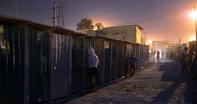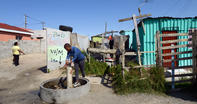Life in Urban Slums
Our cities’ economies and infrastructures cannot absorb the number of people flowing in from the countryside year after year. Many newly urbanised people end up living the precarious life of a slum dweller: off the grid, without reliable access to clean water or electricity, with poor sanitation, in overcrowded homes and faced with the kinds of conditions that push people into risky behaviour.

HIV prevalence is highest in our slums. Food security for people living here is about being able to plug into the city’s grids, getting water and power into their homes, keeping food clean and sanitary, getting nutritious food to immune-compromised people, and finding ways to buffer slum dwellers against the extreme weather events that are inevitable with climate change.
Slums are generally poorly serviced and there is a greater risk of exposure to the kinds of conditions that cause diarrhoeal disease. For someone with a compromised immune system, the risk to their health is greater.
When you follow the complex web of issues involving good nutrition, sanitary food, good service delivery to people living in grimy slums, and then climate change, there are myriad points at which they overlap with food security concerns. And yet they are often overlooked in the conversation because of the ‘food security is about agriculture’ myopia.
Communities of Shacks
Linah is lucky enough to have a bricks-and-mortar home. It is nothing fancy, and the place has that slightly raw finish so typical of RDP houses (the state-subsidised houses, some of which are now known as the Breaking New Ground initiatives).
But it is a solid, formal structure. In theory, the people living in these homes should be better off because they have a tap with cold running water in the kitchen basin, at least, and a flushing toilet in the next room.
Many of the people Linah sees through the network are stuck in the tin and wooden shanties which still dot this township. None of the shacks have running water, and people have to collect it from the nearby standpipes in buckets, tubs or jugs.
The skyline above them bristles with higgledy-piggledy poles – slim, tall, bent, crooked – which hold aloft a tangle of electricity cables that siphon current off the grid and into some of these rudimentary shelters.
How much does the structure of a person’s dwelling impact on their food security status? In terms of basic access to food, the people living in this kind of community are probably equally food insecure, regardless of whether they live in a formal home or a shack because, for the most part, they are probably similarly poor and cash-strapped.
However, research does show a difference in food security status between those living in shacks, and those who can afford to buy or rent their own formal homes.
Firstly, the structure of a house is a visual expression of a family’s wealth and resources, or lack thereof, according to a Development Bank of Southern Africa (DBSA) report on the state of food security in South Africa. Unsurprisingly, the report states, there is a direct relationship between the type of structure a family lives in and its state of food security.
Food Security: Formal vs Informal Housing

In a 2008 survey of households in Cape Town, Jo’burg and Msunduzi (Pietermaritzburg), some of the more food secure families were found to live in formal homes – houses, flats or townhouses. Those families living in informal housing and traditional dwellings tended to be much less food secure. Commenting on this, Dr Jane Battersby says researchers are not entirely sure why this might be.
It is not just about wealth that gives access to food – a bricks-and-mortar family is going to be slightly better off, and so will be more likely to have the cash to tap into the food flows within the city.
And since a family’s level of food security is linked directly to income, and a family able to afford to pay to live in a formal house is more likely to have a better income than a family that can only afford a shack, a shack then becomes a proxy measure for a family’s state of food security. ‘Poverty is the most important predictor of food insecurity,’ states the DBSA report.
And what clearer a sign is there that someone lives in poverty than a shack? But there is something about the nature of the structure itself that also influences a family’s food security levels, at least from a food safety perspective. A formal structure that is on the grid – with water, electricity, fridges, stoves and proper cupboards – is probably going to be a safer space to store and prepare food.
So food will be protected from the elements during heat-waves or floods, from pests, and from the kind of contamination that causes people to get sick. They will be able to keep it clean and cook it properly, something that has significant health implications for anyone handling and eating the food.
Slums Show Highest Rates of HIV
Unsurprisingly, there is also a strong overlap between poverty, the places where informal urban settlements tend to mushroom, and the prevalence of HIV. According to the DBSA report, the highest rates of HIV infection in South Africa are recorded in urban slums. The same might well be true in other SADC country cities.
The reasons for this double-edged sword are myriad, and link into ‘a number of poverty-related factors, including overcrowding, poor access to medical facilities, high levels of mobility, risky poverty-induced behaviour, and substance abuse.
In addition to the lack of access to medical facilities, it is plausible that generally poor levels of physical and social infrastructure in informal areas would also contribute directly to poor levels of social, psychological, emotional and physical health, thus increasing susceptibility to HIV and other diseases.’ And then, to look at this through the lens of food, the highest rates of food insecurity are also here, in the cities, slums and shacklands.
By Leonie Joubert